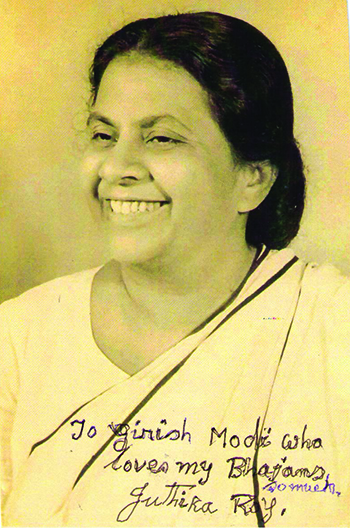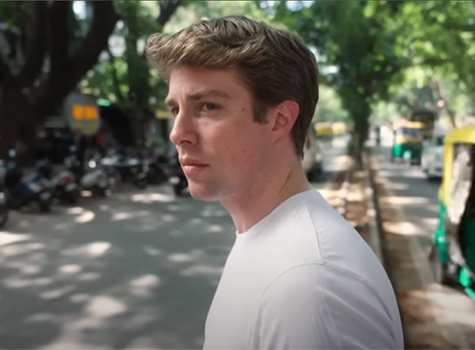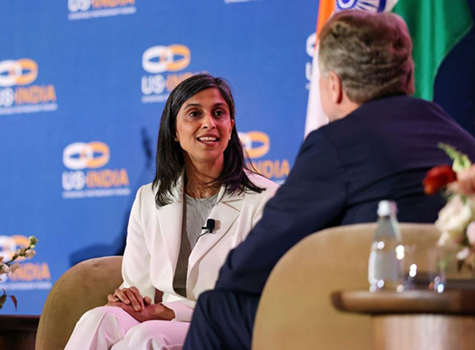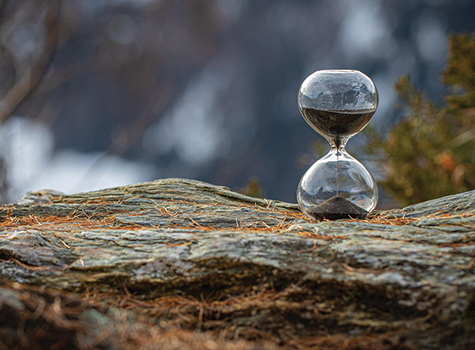By Girish Modi
 When we think of 15th century saint-poetess Meerabai and her couplets and devotional songs (bhajans) in the praise and worship of Lord Krishna, the first person that comes to mind is Juthika Roy who was called “Adhunik Meera” by many who have known her and/or heard her famous bhajans.
When we think of 15th century saint-poetess Meerabai and her couplets and devotional songs (bhajans) in the praise and worship of Lord Krishna, the first person that comes to mind is Juthika Roy who was called “Adhunik Meera” by many who have known her and/or heard her famous bhajans.
Just like Meerabai who at age of seven had become deeply enamored by a statue of Lord Krishna and kept it all her life, Juthiuka Roy too was deeply interested in singing bhajans from age six. She followed Meerabai’s message that Krishna bhakti is the best way to live life as it helps us forget our desires and this in turn helps us attain moksha (liberation).
Since Radio was the only media in 1930s to express one’s musical talent, Juthika’s father used to take young Juthika to Kolkata Radio many times for audition and was repeatedly told that she was too young and was not ready for prime time. Without getting discouraged Juthika continued practicing singing. Her first record was released soon after and she was on her way to becoming a great singer. She was groomed by Kazi Nazrul as well as Kamal Das Gupta, who was a very famous music director/composer at that time.
Juthika Roy was perhaps the only singer who dominated airwaves for over 25 years not by singing filmy songs but by singing bhajans and geets in Hindi and Bengali languages. She has sung no more than 200 songs/bhajans in her lifetime, but almost all of have become popular and are evergreen even today.
It has been reported that Juthika Roy had inspired Lata Mangeshkar, Anuradha Paudwal, Anup Jalota and others to sing Meerabai’s bhajans and released their own albums. The secret to Roy’s success was her soft, melodious and silken voice that stirs up one’s emotions and spiritual side. Also, her bhajans had become popular because they were composed by Kamal Das Gupta using very simple classical instruments.
 Juthika Roy had the honor of singing bhajans on the 15th of August 1947 on the Read Fort at the request of late Jawaharlal Nehru. Later that day she attended a function at the prime minister’s residence and entertained the guests. Juthika Roy had also met Gandhiji when he visited Kolkata in 1946 and sang a couple of his favorite bhajans at his request. Indira Gandhi was also very fond of Juthika’s bhajans and had befittingly awarded her Padma Shri title in 1972. Even after she retired, she was facilitated for her contribution throughout India.
Juthika Roy had the honor of singing bhajans on the 15th of August 1947 on the Read Fort at the request of late Jawaharlal Nehru. Later that day she attended a function at the prime minister’s residence and entertained the guests. Juthika Roy had also met Gandhiji when he visited Kolkata in 1946 and sang a couple of his favorite bhajans at his request. Indira Gandhi was also very fond of Juthika’s bhajans and had befittingly awarded her Padma Shri title in 1972. Even after she retired, she was facilitated for her contribution throughout India.
I can vouch for the divinity of Juthika Roy’s bhajans. We had a gramophone in our house and my father used to play Juthika Roy’s bhajan records “ghoonghat ka pat khol..”, “Nainan mere tumari aur..” etc. every morning that would wake us up slowly and gently. I remember these bhajans by heart today even after 75 years and hum them every now and then. My favorite though is her geet “meri bina ro rahi hai..” which brings tears in my eyes.
When I was living in Montgomery, Alabama, I contacted Juthika Roy first by letters and then by phone calls. We used to talk twice a week. I used to call her didi and she used to call me bhai. In my first letter I had sent her a check for Rs. 25,000 for celebration of her birthday. In a second letter she had written to me about her career.
Juthika Roy had sent me lyrics of “meri bina ro rahi hai..” in her own words, because I had a hard time understanding some of the words. Find this song on YouTube. Roy had also sent me her autographed photo on which she had written “To Girish Modi, who loves my bhajans so much”, which I treasure most.
Girish Modi is an 85-year old retired engineer who is passionate about Indian music and classical dances. He donates money to various Indian organizations and provides free photo service.



